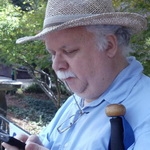Roger2 wrote:adipasqu wrote:
Timed breaths. The machine calculates your average breathing rate over a period of time (4 minutes, I believe for the PRS1 ASV). If you fail to breathe according to that rate, the machine will initiate a breath for you.
-A
Do all machines have this or just the more deluxe ones? I have a ResMed S9 Elite, does that have this capability?
I had not heard of this term before but then I have only been on cpap therapy for about 2 months so I am sure there is a LOT more that I am unfamiliar with.
Roger
Greetings Roger2! Welcome to the Hose Head World!
The machine you have does not do this. There are several different Positive Airway Pressure therapies:
- CPAP Therapy - The continuous PAP. What you use.
- BiPAP (or Bi-Level) Therapy - The inhalation pressure is greater than exhalation pressure. This makes it easier to exhale against the Positive Airway Pressure.
- BiPAP S/T Therapy - Your breathing is timed. If you fail to breathe often enough the machine kicks switches to inhalation pressure in an attempt to "remind" you to breathe.
- ASV Therapy - This is usually a Bi-Level machine with ventilation support. adipasqu was off a little bit in the definition. Rather than just tracking the frequency of your breathing, an ASV machine tracks the volume of air that you breathe. If you next breath falls below the moving 3 (or 4 ... depending on the manufacturer) minute average, then the machine will increase the pressure to assist respiration. That's why it is known as Adaptive Servo-Ventilation (ASV) therapy.
There are other therapies. For example there is AVAPS, which helps people with Chronic Obstructive Pulmonary Disease (COPD). And no doubt more will be developed.
The ASV therapy is used to treat central sleep apnea in its various forms. There are two primary reasons why central sleep apnea occurs.
First, you might have a physiological problem that interferes with regulation of CO2 in the blood. This often happens with heart failure, which can lead to Cheyne-Stokes Respiration (CSR) and central sleep apnea. The brain is doing its job, but the mechanism to regulate CO2 is "broken". By acting as a respirator, the ASV helps break the undershoot / overshoot cycle of CO2 buildup and depletion. The ASV helps maintain the proper CO2 levels in the blood. (It is actually CO2 that drives respiration, not O2).
The other reason central sleep apnea occurs is due to poor central nervous system function. Though the body might have no cardiovascular problems, the central nervous system fails to properly signal the muscles during respiration. This often occurs due to some problem with the brain stem. It may also occur due to the use of opiates (often for pain management). In this case, the ASV also acts as a respirator during the time of poor respiration. This again helps maintain the proper CO2 levels. As a result the cycle of undershoot / overshoot is also broken.
I know that's probably a LOT more information than you wanted, but I figured your honest question deserved a good answer. Hope that helps.














